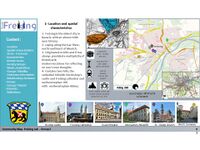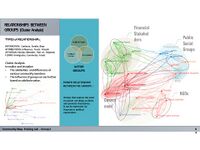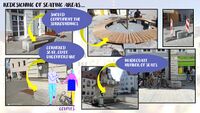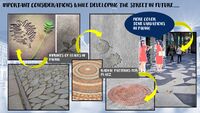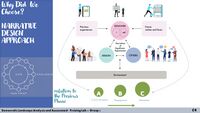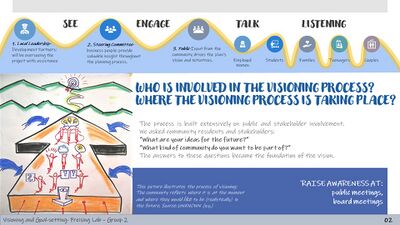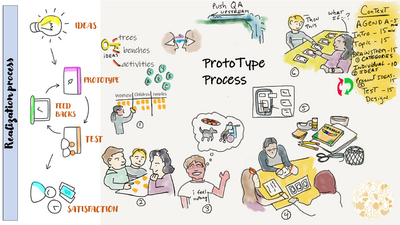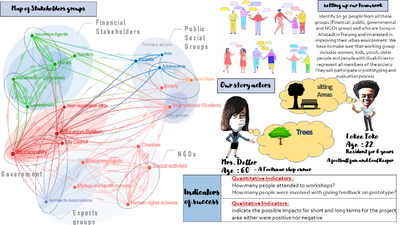LED2LEAP 2020 - Freising Team 2: Difference between revisions
| (24 intermediate revisions by the same user not shown) | |||
| Line 194: | Line 194: | ||
*POWER, CONFLICTS, INTERESTS MATRIX<br> | *POWER, CONFLICTS, INTERESTS MATRIX<br> | ||
<gallery> | <gallery caption=" " widths="200px" heights="150px" perrow="5"> | ||
File:Team2PhaseASlide6.PNG|REFLECTIONS | File:Team2PhaseASlide6.PNG|REFLECTIONS | ||
</gallery> | </gallery> | ||
| Line 286: | Line 285: | ||
''' | '''Landscape analysis'''<br> | ||
by hearing the stories we can reach a better understanding of landscape. People mostly talk about needs, wanting and desires. | |||
* ''stakeholder mapping.'' | |||
* '' | * ''Data collection.'' | ||
* ''Data collection | * ''Data analysis.'' | ||
* ''Data analysis. | |||
<gallery caption=" " widths="200px" heights="150px" perrow="5"> | <gallery caption=" " widths="200px" heights="150px" perrow="5"> | ||
| Line 370: | Line 368: | ||
= Phase D: Collaborative Design, Transformation and Planning = | = Phase D: Collaborative Design, Transformation and Planning = | ||
== Your Prototyping Action== | == Your Prototyping Action== | ||
* | *Exhibitions Events, games for kids, snacks, Music, dancing | ||
identify if people are happy with present scenario of the street.<br> | |||
identify the views, needs, desires of people to make Aldstadt a better place.<br> | |||
realize if our visions and our goals match the people’s need /views / desires. | |||
<gallery caption=" " widths="400px" heights="300px" perrow="3"> | <gallery caption=" " widths="400px" heights="300px" perrow="3"> | ||
| Line 381: | Line 384: | ||
== The Evolution of Your Prototyping Action == | == The Evolution of Your Prototyping Action == | ||
* | * Preparing creative tools for open discussion | ||
* | * Not only limited workshops but also opening permanent connection fields to share different ideas | ||
* | * Arranging meetings to present and advocate for their added ideas | ||
* Organizing final workshops to prioritize the proposed ideas | |||
'''Based on all previous actions we come up with final results to develop our prototype with a possibility for extending the sustainable development to the surrounding districts | |||
''' | |||
<gallery caption=" " widths="400px" heights="300px" perrow="3"> | <gallery caption=" " widths="400px" heights="300px" perrow="3"> | ||
| Line 390: | Line 396: | ||
== The Plan Behind Your Prototyping Action == | == The Plan Behind Your Prototyping Action == | ||
Step 1: Requirements gathering and analysis. A prototyping model starts with requirement analysis. ...<br> | |||
Step 2: Quick design. ...<br> | |||
Step 3: Build a Prototype. ...<br> | |||
Step 4: Initial user evaluation. ...<br> | |||
Step 5: Refining prototype. ...<br> | |||
Step 6: Implementation.<br> | |||
<gallery caption=" " widths="400px" heights="300px" perrow="3"> | <gallery caption=" " widths="400px" heights="300px" perrow="3"> | ||
| Line 399: | Line 411: | ||
== The Realization of Your Prototyping Action == | == The Realization of Your Prototyping Action == | ||
*''What happened, who was there and what was the atmosphere like among the participants?'' | *''What happened, who was there and what was the atmosphere like among the participants?'' | ||
* | |||
* Choosing the right type of prototype | |||
* Setting concrete goals: Having a clear idea | |||
* Using the right tools | |||
* Taking actions! Design Thinking is all about generating ideas and testing them, so prototype as and when weneed to. | |||
<gallery caption=" " widths="400px" heights="300px" perrow="3"> | <gallery caption=" " widths="400px" heights="300px" perrow="3"> | ||
| Line 407: | Line 423: | ||
== Reflect on Your Prototyping Action == | == Reflect on Your Prototyping Action == | ||
*''In the end, what change did the intervention create? How would you adjust it to be more effective if you did it again? Consider what it means to be successful, what indicators would you use to measure success in this endeavor? Most importantly, how did your intervention reflect the material in the Phase D lectures?'' | *''In the end, what change did the intervention create? How would you adjust it to be more effective if you did it again? Consider what it means to be successful, what indicators would you use to measure success in this endeavor? Most importantly, how did your intervention reflect the material in the Phase D lectures?'' | ||
Prototypes come in all different Projects and sizes, ranging from simple models to fully functional, interactive prototypes.<br> | |||
We’ll look at some of the different types of prototype. | |||
* Participation is a power of change | |||
* Timely creative workshops | |||
* increased economic value of shops , restaurants | |||
* multiple use of open spacesand facilities | |||
<gallery caption=" " widths="400px" heights="300px" perrow="3"> | <gallery caption=" " widths="400px" heights="300px" perrow="3"> | ||
File:Team2PhaseDSlide8.PNG|''add a caption'' | File:Team2PhaseDSlide8.PNG|''add a caption'' | ||
| Line 416: | Line 443: | ||
== Collaborative Evaluation and Landscape Democracy Reflection == | == Collaborative Evaluation and Landscape Democracy Reflection == | ||
*''Reiterate your landscape democracy challenge, by listing the relevant UN Sustainable Development Goals. How has the your work with he community this far affect your perceptions of theses goals in regards to the LD challenge? How has your team, or community partner, modified these goals over the course of this course?’' | *''Reiterate your landscape democracy challenge, by listing the relevant UN Sustainable Development Goals. How has the your work with he community this far affect your perceptions of theses goals in regards to the LD challenge? How has your team, or community partner, modified these goals over the course of this course?’' | ||
'''SUSTAINABLE DEVELOPMENT GOAL 11 | |||
'''Make cities and human settlements inclusive, safe, resilient and sustainable | |||
Challange: | |||
Lack of green spaces and recreational areas in Altstadt of Freising where the lively historic center of the cathedral city is located between Domberg and Weihenstephaner Berg.<br> | |||
This layout of Altstadt from 1159 has been largely preserved to this day. The challenge here is to add new landscape value to the old and historical space | |||
<gallery caption=" " widths="400px" heights="300px" perrow="5"> | <gallery caption=" " widths="400px" heights="300px" perrow="5"> | ||
| Line 423: | Line 455: | ||
== The Actors in your Collaborative Evaluation == | == The Actors in your Collaborative Evaluation == | ||
The evaluation of modeling processes for years has focused on assessing the outcome of modeling, while the process of modeling itself hardly has been subject of examination. in our experience, with rising interest in collaborative conceptual modeling approaches, the process of modeling has gained more attention. | |||
Identify 20-30 people from all these groups (Financial, public, governmental and NGOs group) and who are living in Altstadt in Freising and interested in improving their urban environment. We have to make sure that working group includes women, kids, youth, older people and people with disabilities to represent all members of the society. | |||
They will participate in prototyping and evaluation process | |||
<gallery caption=" " widths="400px" heights="300px" perrow="5"> | <gallery caption=" " widths="400px" heights="300px" perrow="5"> | ||
| Line 433: | Line 469: | ||
== Reflection of the Online Seminar == | == Reflection of the Online Seminar == | ||
*’'How did the pandemic affect | *’'How did the pandemic affect learning ? | ||
* | |||
* ''what we liked the most from learning methods in that course is working with MURAL'' | |||
* ''It affect on teamwork negatively'' | |||
* ''Logic and clear sequence of course phases which helps us a lot to fully understand what to first and what we needs and how to apply our ideas.'' | |||
<gallery caption=" " widths="400px" heights="300px" perrow="4"> | <gallery caption=" " widths="400px" heights="300px" perrow="4"> | ||
| Line 441: | Line 481: | ||
== Reflection of the Living Lab Process == | == Reflection of the Living Lab Process == | ||
The COVID-19 crisis has impacted cities throughout the world. The disease’s worst effects are closely linked with urban areas, where death rates tend to be higher because of a complex combination of factors, including population density, national and international connectivity and public health response. major urban areas have higher death rates than other types of settlement, and city size has also been found to play an important part in determining infection rates. | |||
so, for a period of time, the Lab could not have activities to communicate with people. | |||
<gallery caption=" " widths="400px" heights="300px" perrow="5"> | <gallery caption=" " widths="400px" heights="300px" perrow="5"> | ||
| Line 449: | Line 491: | ||
== Your Living Lab Code of Conduct == | == Your Living Lab Code of Conduct == | ||
<gallery caption=" " widths="400px" heights="300px" perrow="5"> | <gallery caption=" " widths="400px" heights="300px" perrow="5"> | ||
File:Team2PhaseESlide7.PNG|''add a caption'' | File:Team2PhaseESlide7.PNG|''add a caption'' | ||
File:Team2PhaseESlide9.PNG|''add a caption'' | |||
</gallery> | </gallery> | ||
= Process Reflection = | = Process Reflection = | ||
* | |||
* | * that would be valuable if we would be able to look back and forth in the process and make necessary additions/ subtractions in concept | ||
* | * we learned that a landscape project in Design thining should being organized , focusing more on details and accepting opinion difference | ||
* | * It was clear in the process that we need a broad knowledge and understanding of the rights, needs and desires of all citizens as well as an understanding of forms of public spaces to develop our idea about changes. | ||
* during the project we undrestood that it is necessary to respect the power of community in making the environmental change and our role as a landscape planner towards the community is to offer different and creative ways for public participation in the environmental change process | |||
<gallery> | <gallery> | ||
</gallery> | </gallery> | ||
Latest revision as of 18:50, 19 July 2020
>>>back to working groups overview
Landscape Democracy Rationale
- Why do you think this community context is relevant from a landscape democracy perspective? What is your hypothesis considering the landscape democracy challenges?
We believe that we can solve the problems in question in order to Democratic landscape perspective in Freising.
It means that there is capacity to see the broad picture on Integrated actions at the landscape scale in Freising which allow groups to evolve dynamically.
ASSUMPTIONS:
All communities and Voices are equel.
Individuels have the ability to make changes.
Every group has its own values.
Location and scope
- The Location is located in Freising.
- Our main focus area is the old town of Freising.
Phase A: Mapping your Community
Groups of actors and stakeholders in your community
- Which groups/sub-communities are there? What are their needs and aspirations with regard to the landscape? Which groups are more visible? Which are less visible? What do we not know?
SOCIAL GROUPS:
- political actors (Political parties, politicians )
- NGOs ( Environmental “German Environmental Aid Association”, social ”Caritas”, health “Gesundheitszentrum Kneippgarten”, Human rights … ) ( Non-profitable )
- public groups ( elderly, parent students, , single parents, adolescents ,International students, )
- Brands’ customers ( Apple, Adidas, Nike, ..etc )
- competitors ( sports clubs )
Needs
Income Increase
+
Social Connections
+
Better connection to public transportation
+
Housing Facilities
Aspirations
Better life conditions
+
Be more involved in Society
+
Financial support
+
Social Support
+
connection with other single parents
+
More Job opportunities
+
Increase the number of bus stations
+
Easier renting process
_________________________________________________________________________________________________________________________________
LOCAL STAKEHOLDERS:
- Retailers
- Breweries
- Associations ( City Marketing Association, Inner city management Association,City Economic Development Agency,.... etc)
- Religious Organizations
- Profitable Organizations.
Needs
Investment
+
Financial Stability
Aspirations
More Income
+
More Effective role in life quality Development
+
Growing business with higher profits
+
More social Impact on people’s lives
_________________________________________________________________________________________________________________________________
*EXTERNAL STAKEHOLDERS:
- Financial stakeholders: (Banks, Shareholders, Insurance Companies, Construction Companies)
- Governmental Groups: (National Authorities ( Mayor, City Council, ... etc), Government offices, Education System, Health System)
Needs
social support
Aspirations
More development for both economical and social sector
+
Better life and health for all citizens
+
Better education system
Relationships between your actors and groups
- How would you describe the power relationship between the groups?
the external groups and Finantial Stakeholders express the need for power to do so direct and promote themselves. It is expressed by financial or political expressions .
- Which groups may have shared interests and which are these?
Social Groups and and Education system express have similarities in various members.
NGOs and Government have some Influences of social groups on each other based on attribute value.
TYPES of RELATIONSHIPs:
- INTERACTION: Contacts, Emails, Buys
- ATTRIBUTIONS: Influences, Trusts, Friends
- AFFILITIAN: Similar, Member, Part of, Depends
- FLOWS: Immigrates, Commutes, Feeds
SHARED INTERESTS:
- common objectives
- common goals
- well-integrated manner
POWER RELATIONSHIP :
- Authority
- Leadership
- control tend to be preferred
CONFLICTS
It exists as a latent rather than manifest characteristic of society.
A conflict of interest or power is a situation in which a person or organization is involved in multiple interests, financial or otherwise, and serving one interest could involve working against another. Typically, this relates to situations in which the personal interest of an individual or organization might adversely affect a duty owed to make decisions for the benefit of a third party.
Summary of your learnings from the transnational discussion panel on April 22
On April 22 you will present the PPT version of this first assignment to other seminar groups working in other geographical community contexts.
- Cluster Analysis:
to realize and visualize:
The similarities and differences of various community members
The Influence of groups on each other based on attribute value.
- POWER, CONFLICTS, INTERESTS MATRIX
Theory reflection
We have seen so far that ‘democracy’ is a complex concept including at least three different sets of values drawing in different directions. Self-determination focuses on the promotion of free scope for autonomous individuals. Codetermination demands equal consideration or access to infuence on common decisions. Respect for argument stresses the need to justify wishes and requests with reasons one expects to be acceptable to all. The frst part of the Demorcy is the quest for democracy, followed by various methods that may be applied in order to make landscape decisions more democratic. We used this Method as a means of involving stakeholders in the democratic process of defning goals and objectives in local landscapes.
References
- https://www.ukessays.com/essays/education/stakeholders-into-primary-and-secondary.php
- https://subjecto.com/stakeholders-mapping-and-power-interest-matrix
- Juliane Schütt, Katharina Löhr, Michelle Bonatti and Stefan Sieber, Conflict Causes and Prevention Strategies at the Society-Science Nexus in Transdisciplinary Collaborative Research Settings: A Case Study of a Food Security Project in Tanzania, Sustainability, 10.3390/su11226239, 11, 22, (6239), (2019).
- Moura, H.M. and Teixeira, J.C. (2010). Managing Stakeholders Conflicts. In Construction Stakeholder Management (eds E. Chinyio and P. Olomolaiye). doi:10.1002/9781444315349.ch17
- https://www.bayer.com/en/stakeholder-dialogue.aspx
- https://www.hier-sind-die-fakten.de/de/aktueller-stand-zu-den-stakeholder-listen-von-monsanto.aspx
Phase B: Democratic Landscape Analysis and Assessment
The Scene in your Story of Analysis
1- Landscape democracy challenge :
Lack of green spaces and recreational areas in Altstadt of Freising
lively historic center of the cathedral city between Domberg and Weihenstephaner Berg.
This layout of Altstadt from 1159 has been largely preserved to this day.
2- Description of the physical historical scene :
1- The center of this historical story started while Domberg was officially confirmed as a bishopric in 739 AD, in the 9th and 10th centuries the civil town at the foot of the Domberg gradually emerged as a suburbium.
2- The most popular square in Freising is Marienplatz where all city festivals are celebrated with the highly visible Marian column from 1674.
3- The colored building’s facades with detailed decorations of Gothic and Baroque palaces along the old town streets.
4-At Marienplatz is located the baroque Asam museum, the former prince-bishop's college.
5- Rathaus in Marienplatz was built in 1904 in the style of old German official buildings from the late Middle Ages and the Renaissance.
6- Behind Rathaus it is located Gothic St. Georg church.Its tower go up the 84 meters and it is considered one of the most beautiful baroque towers in old Bavaria.
3- Socio-economic and political characteristics :
1- Marienplatz is considered a very popular meeting place for locals and guests in Freising.
2- Along the Altstadt streets there are beautiful boutiques, shops, cafés and restaurants with a length of around 960 meter on the main street.
3- In the Altstadt is located 8 different bank branches in one old street.
4- Contextual elements
1- Historical background
2- Marinplatz & Rathaus
3- Domberg
4- St. Georg church
5- Shops & Restaurants
6- Banks
7- Gothic and Baroque building’s facades
The Actors in your Story of Analysis
- Describe the characters and their role in the story. Are they major or minor characters? Are there any key relationships that need to be defined?
- add the corresponding visual from your presentation to the image gallery below
Stakeholder and key actors
Women & Girls, Couples, Famlies, Teenagers, Students
Roles of Actors
Secondary Character, Main Character, Flat Character
Their Acts
Dynamic, changing, Static, unchanging,Stock
The Story of Analysis
Reflect on your Story of Analysis
Landscape analysis
by hearing the stories we can reach a better understanding of landscape. People mostly talk about needs, wanting and desires.
- stakeholder mapping.
- Data collection.
- Data analysis.
Phase C: Collaborative Visioning and Goal Setting
The Scene in your Story of Visioning
1- Landscape democracy challenge:
Lack of green spaces and recreational areas in Altstadt of Freising where the lively historic center of the cathedral city is located between Domberg and Weihenstephaner Berg.
The challenge here is to add new landscape value to the old and historical space
problem-statement based on the landscape evaluation and assessment
- Attractive landscape elements challenge
- Social & Culture Identity Challenge
- Accessibility Challenge
The Actors in your Story of Visioning
1. Local Leadership- Development Partners: will be overseeing the project with assistance
2. Steering Committee-business people: provide valuable insight throughout the planning process.
3. Public-Input from the community drives the plan’s vision and initiatives.
The process is built extensively on public and stakeholder involvement. We asked community residents and stakeholders:
- “What are your ideas for the future?”
- “What kind of community do you want to be part of?”
The answers to these questions became the foundation of the vision.
The Story of Visioning
The main points most of the stakeholders agreed on are the lack of sitting areas and no trees in the whole area.
The main goals
- Providing more sitting areas.
- Planting enough trees to provide shade for the sitting areas and to reduce the heat island effect.
Reflect on your Story of Visioning
The values, attitudes and needs should be considered in formulating goals, to determine useful and achievable goals.
It can be written by answering the following questions:
- what do (target group, sector, etc.) needs?
- Why is it needed – for what purpose?
- What type of capacity is needed in order to achieve the purpose?
Phase D: Collaborative Design, Transformation and Planning
Your Prototyping Action
- Exhibitions Events, games for kids, snacks, Music, dancing
identify if people are happy with present scenario of the street.
identify the views, needs, desires of people to make Aldstadt a better place.
realize if our visions and our goals match the people’s need /views / desires.
The Evolution of Your Prototyping Action
- Preparing creative tools for open discussion
- Not only limited workshops but also opening permanent connection fields to share different ideas
- Arranging meetings to present and advocate for their added ideas
- Organizing final workshops to prioritize the proposed ideas
Based on all previous actions we come up with final results to develop our prototype with a possibility for extending the sustainable development to the surrounding districts
The Plan Behind Your Prototyping Action
Step 1: Requirements gathering and analysis. A prototyping model starts with requirement analysis. ...
Step 2: Quick design. ...
Step 3: Build a Prototype. ...
Step 4: Initial user evaluation. ...
Step 5: Refining prototype. ...
Step 6: Implementation.
The Realization of Your Prototyping Action
- What happened, who was there and what was the atmosphere like among the participants?
- Choosing the right type of prototype
- Setting concrete goals: Having a clear idea
- Using the right tools
- Taking actions! Design Thinking is all about generating ideas and testing them, so prototype as and when weneed to.
Reflect on Your Prototyping Action
- In the end, what change did the intervention create? How would you adjust it to be more effective if you did it again? Consider what it means to be successful, what indicators would you use to measure success in this endeavor? Most importantly, how did your intervention reflect the material in the Phase D lectures?
Prototypes come in all different Projects and sizes, ranging from simple models to fully functional, interactive prototypes.
We’ll look at some of the different types of prototype.
- Participation is a power of change
- Timely creative workshops
- increased economic value of shops , restaurants
- multiple use of open spacesand facilities
Phase E: Collaborative Evaluation and Future Agendas
Collaborative Evaluation and Landscape Democracy Reflection
- Reiterate your landscape democracy challenge, by listing the relevant UN Sustainable Development Goals. How has the your work with he community this far affect your perceptions of theses goals in regards to the LD challenge? How has your team, or community partner, modified these goals over the course of this course?’'
SUSTAINABLE DEVELOPMENT GOAL 11 Make cities and human settlements inclusive, safe, resilient and sustainable
Challange:
Lack of green spaces and recreational areas in Altstadt of Freising where the lively historic center of the cathedral city is located between Domberg and Weihenstephaner Berg.
This layout of Altstadt from 1159 has been largely preserved to this day. The challenge here is to add new landscape value to the old and historical space
The Actors in your Collaborative Evaluation
The evaluation of modeling processes for years has focused on assessing the outcome of modeling, while the process of modeling itself hardly has been subject of examination. in our experience, with rising interest in collaborative conceptual modeling approaches, the process of modeling has gained more attention.
Identify 20-30 people from all these groups (Financial, public, governmental and NGOs group) and who are living in Altstadt in Freising and interested in improving their urban environment. We have to make sure that working group includes women, kids, youth, older people and people with disabilities to represent all members of the society.
They will participate in prototyping and evaluation process
Reflection of the Online Seminar
- ’'How did the pandemic affect learning ?
- what we liked the most from learning methods in that course is working with MURAL
- It affect on teamwork negatively
- Logic and clear sequence of course phases which helps us a lot to fully understand what to first and what we needs and how to apply our ideas.
Reflection of the Living Lab Process
The COVID-19 crisis has impacted cities throughout the world. The disease’s worst effects are closely linked with urban areas, where death rates tend to be higher because of a complex combination of factors, including population density, national and international connectivity and public health response. major urban areas have higher death rates than other types of settlement, and city size has also been found to play an important part in determining infection rates. so, for a period of time, the Lab could not have activities to communicate with people.
Your Living Lab Code of Conduct
Process Reflection
- that would be valuable if we would be able to look back and forth in the process and make necessary additions/ subtractions in concept
- we learned that a landscape project in Design thining should being organized , focusing more on details and accepting opinion difference
- It was clear in the process that we need a broad knowledge and understanding of the rights, needs and desires of all citizens as well as an understanding of forms of public spaces to develop our idea about changes.
- during the project we undrestood that it is necessary to respect the power of community in making the environmental change and our role as a landscape planner towards the community is to offer different and creative ways for public participation in the environmental change process

